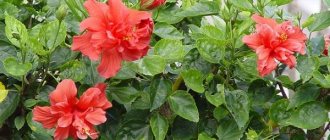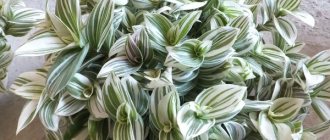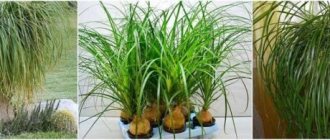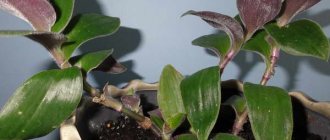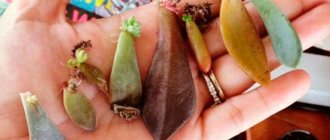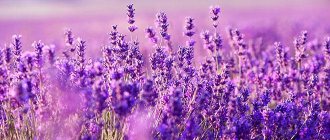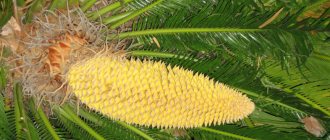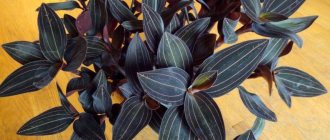Tradescantia is a decorative vine from the Commelinaceae family. The homeland of the evergreen perennial is South America. The wild culture was brought to Europe at the beginning of the 17th century. The court botanist and gardener John Tradescant, together with his son, also named John, traveled the world and collected exotic plants. In the royal parks they studied and bred Tradescantia. The flower is named in their honor.
What is Tradescantia
This is a plant belonging to the genus of perennial evergreens. Belongs to the Commelinaceae family. This plant is also called netcreasia, zebrina. The name Tradescantia was given to it in the 18th century in honor of the gardener, botanist and aquarist John Tradescant the Elder. He worked for King Charles I of England and was the first to describe the nature of the plant. Names such as “woman's gossip” and “saxifrage” are very common among people.
What does it look like
The plant is perennial, low-growing, herbaceous. Has straight or creeping stems. Leaves are alternate, lanceolate, ovate, elliptical. Their color, depending on the variety, varies from green to red. The leaves are sometimes covered with stripes. The inflorescences are axillary, apical, and have sepals. The color of flowers depends on many factors; they can be white, pink, purple, lilac, deep purple.
Homeland of Tradescantia
Its natural habitat is the tropical and temperate zones of America, it extends from southern Canada to northern Argentina. In North America, the plant is considered one of the most harmful weeds. Tradescantia is very common. Many of its varieties are found in houses, apartments, and winter gardens. The exact natural habitat depends on the specific variety.
Why do you dream?
- If you dreamed of this flower, changes await you in your personal life. Seeing Tradescantia in a dream means that soon a person will appear, a relationship with whom will bring many happy moments and fill life with new meaning.
- For a woman, a dream in which tradescantia is present promises to receive unambiguous signs of attention. For a man, such a dream predicts that he will soon meet a girl who will be a good housewife, capable of creating comfort in the house.
- If people are present with the flower, then soon you will participate in a wedding celebration or a magnificent celebration of a birthday or name day. If you dreamed of Tradescantia with animals, then you will meet with an old friend.
- Other sources interpret the tradescantia seen in a dream as a warning about upcoming worries and excitement before a responsible task.
Types of Tradescantia
There are many types of plants, some even poisonous. They all fall into two broad categories. Garden hybrids include the following types:
- Anderson and its varieties;
- Virginskaya;
- Scaphoid;
- Sillamontana;
- Purple;
- Reo bractulatum (Tradescantia variegated);
- Riverside (quicksilver).
There are those subspecies that are more suitable for keeping indoors. These include the following types and varieties:
- White-flowered;
- Motley;
- Zebra-shaped (hanging);
- Blossfeld.
Garden hybrids
There are many varieties of the flower that can survive outdoors. The most common is Anderson's Tradescantia (Tradescantia Andersoniana). Belongs to the category of complex garden hybrids. The leaves are linear-lanceolate, violet-green in color. The plant reaches from 30 to 80 cm in height. Stems are branched, angular, erect. The flowers are flat. They come in pink, white, purple, and blue. Tradescantia blooms from early summer until September. There are several varieties, characteristics of the best:
- JG Weguelin. With large bright blue flowers.
- Osprey. The petals are white.
- Sweet Kate. Dark blue flowers.
- Leonora. Purple petals with a blue tint.
- Purewell Giant. The flowers are carmine red.
- Iris. Rich blue Petals.
- Innocence. The flowers are white.
- Red Grape. Raspberry petals.
Virginia tradescantia (Tradescantia virginiana) is another garden hybrid, a hardy ground perennial. It is a subspecies of Tradescantia Andersoniana. The height of the erect stems is 50-60 cm. Linear-lanceolate leaves, the length of which is up to 20 cm. Flowers with three petals, up to 4 cm in diameter. The inflorescences are umbellate, on the tops of the stems. The fruit is a capsule that opens with longitudinal flaps. Tradescantia blooms from July to August, the period takes 60-70 days. Different varieties have different petal colors:
- Coerulea – blue;
- Rubra – red;
- Atrorubra – blood red;
- Rosea - pink.
Scaphoid tradescantia (Tradescantia navicularis). A garden succulent plant native to Mexico and Peru. Ampelous, highly decorative. It is characterized by the following features:
- Shoots are bare, creeping.
- Ovate or boat-shaped leaves. They are small, only 2-4 cm in length, up to 1 cm in width. The leaves are thick, keeled below. They are pointed, with cilia along the edges. Densely strewn with purple dots.
- The inflorescence is apical.
- The petals on the flowers are pink and bright.
Tradescantia sillamontana is a very original garden plant. Everything is covered with white hairs, as if wrapped in felt. This is how netcreasia protects from the sun and retains moisture. If the lighting is poor, the villi become sparse. Hairy stems are straight. The leaves are arranged not in two rows, but spirally. There is rooting, underground shoots. The ground part branches and is capable of propagation by cuttings.
Tradescantia crassula is a moisture-loving garden hybrid. The plant has long, thick leaves, almost without a petiole, and absolutely not shiny. They have a noticeable border around the edges. While the leaves are young, they are rolled into one tube. In the sun they quickly fade and become translucent. This variety requires much brighter lighting than other subspecies.
Setcreasea purpurea or pallida is an incredibly popular plant in Argentina. Bright purple color. Stems are erect or slightly decumbent, very thick, succulent. Setcreasia purpurea is often planted along walls, under windows as a border, on lawns and flower beds. The larger the group of seedlings, the more beautiful and impressive it looks. Purple heart blooms with lilac-pink flowers in the warm season.
Riverside or myrtifolia (Tradescantia fluminensis, myrtifolia) is a garden hybrid from Brazil. Peculiarities:
- Sprawling shoots. Purple with light green spots.
- Leaves are ovate. Length – 2-2.5 cm, width – 1.5-2 cm. The top is dark green, the bottom is lilac-red. The leaves are smooth on both sides and have a short petiole.
Indoor varieties and types
Some types of plants can exist indoors. This is the white-flowered Tradescantia albiflora. It is also called tricolor, uridis. It has oblong-broad-ovate leaves. They are pointed at the apex and bare on both sides. Length 4-6 cm, width - 2-2.5 cm. The color of the leaves is green or silver-variegated, the surface is glossy. Creeping shoots. Apical, less often axillary inflorescences, small white flowers. Varieties:
- Aureovittata. The leaves have yellow-golden stripes on top.
- Aurea. The leaves are yellow with green stripes on them.
- Tricolor. Leaves with white and lilac-pink stripes.
- Albovittata. There are white stripes on the leaves.
Tradescantia blossfeldiana is a plant native to Argentina. Perennial, semi-succulent, herbaceous. Stems are greenish-red, erect. The leaves are elliptical or oblong, the apex is acute or pointed. Length - 4-8 cm, width - 1-3 cm. The leaves are dark green, slightly reddish on top, and purple on the bottom, covered with white erect hairs. The flowers are in paired curls, on long stalks, and have stamens. They have three petals, white below, bright pink above.
Zebra or hanging (Tradescantia zebrina or pendula). Houseplant option. It is easy to care for, looks very beautiful and has healing properties. Has creeping or hanging shoots. They are naked, slightly reddish. Oblong ovate leaves, 8-10 cm long and 4-5 cm wide. Their upper surface is green, with two longitudinal stripes of a silvery hue. The leaves are red below. The flowers are violet or purple, small.
Tradescantia multicolor is a very beautiful, unpretentious small-leaved indoor plant. The main distinctive features of the variegated variety:
- The leaves are dense, small, green. Covered with white or pink stripes.
- Densely growing species.
Caring for Tradescantia at home
The plant is not capricious. It takes root well in almost all rooms and in arid climates. For growing, it is better to choose flowerpots or pots. It is important to maintain a certain temperature regime, choose a properly lit place in the room with optimal air humidity, and use suitable soil. It is necessary to periodically feed the netcreasia with fertilizers and water it regularly.
Temperature and lighting
Setcreasia develops favorably in conditions of diffused bright light, although it can withstand direct sunlight and partial shade. It is best to grow it near windows that face east or west; northern windows are allowed, but southern ones will need shading in summer. Variegated species need more light, otherwise they will lose their color and may turn completely green. The most shade-tolerant type is white-flowered. In summer, flowers can be placed on the balcony.
Netcreasia is less picky about temperature than about lighting. The flower can exist both in a warm room, where the average temperature is 25 degrees, and in a cool room, where the mark on the thermometer does not exceed 8-12C. The white-flowered variety is able to live and develop even at 7C. The influx of fresh air is beneficial for the network; drafts are absolutely not a problem.
Air humidity
This figure should be high. In summer, you need to spray netcreasia more often and moisten its leaves. In winter, the procedure is not necessary. When creating conditions for optimal air humidity, do not overdo it. If spraying is excessive, the leaves and stems may simply rot. To prevent this, the soil in the pot should be loosened periodically.
Proper watering
In spring and summer, netcreation requires a lot of moisture, but the water in the pot should not stagnate. It is recommended to water in a day or two after the top layer of soil dries. In winter, the soil is kept moderately moist. Water two to three days after the top layer dries. Throughout the year, care must be taken to ensure that liquid does not accumulate in the pan. Half an hour after watering, the excess is poured out. The tray is thoroughly wiped.
The water should be soft and well settled. If the plant is kept in a cool room at an air temperature of 12-16 degrees, then it should be watered rarely, only after the soil has completely dried. The Tradescantia flower can remain in a dry earthen lump for a long time, but you need to understand that this will significantly weaken it. To maintain viability, it is advisable not to skip watering.
Soil and fertilizing
The substrate should be selected with humus, with a pH closer to neutral (5.5-6.5). You can use a mixture of two parts deciduous soil and one part each of turf and humus soil and add a little sand. The flower will grow well in such soil. There is an option to purchase ready-made land. Special soil for netcreasias is on sale. Be sure to provide good drainage at the bottom of the pot.
Netcreasia should be fertilized during the growing season. In spring and summer, complex mineral and organic fertilizers must be applied twice a month. It is worth noting that the latter are not suitable for variegated forms. Due to organic fertilizers, the color of the leaves may deteriorate or disappear. In winter and autumn, fertilizing is not done; the plant does not need it.
- How to remove belly and sides quickly at home. Removing side and belly fat with exercises, photo
- What are the benefits of persimmon?
- How to transfer electricity meter readings to a personal account
Difficulties
Poor growth. Elongation of shoots, reduction in the number of leaves due to lack of moisture or nutrients, due to poor lighting.
Greening of leaves. When cultivating variegated varieties, make sure that the lighting is optimal, otherwise the leaves will turn green.
The leaves become covered with spots. If there is a lack of liquid, the shoots will become lethargic and the surface of the leaves will be covered with yellow spots.
Pulling the plant. In winter, the shoots may stretch out, and the leaves at their base will dry out and fly off. In this situation, to rejuvenate the bush, rooted cuttings are used.
Transformation of leaf color to brown. If the air humidity is too low, the ends of the leaves may turn brown.
Uniform leaves. The leaves sometimes lose their stripes and become the same color. This happens due to poor lighting and due to illiterate pruning or cuttings.
Diseases and harmful insects.
In frequent cases, Tradescantia can be affected by rot. When exposed to outdoor conditions, the flower can be harmed by slugs and aphids.
Reproduction and transplantation
As the flower grows, it will need to be moved to larger pots. Setcreasia should be replanted in the spring. Planting is carried out once a year for young individuals and once every two or three for adults. In the process you need to trim the shoots. The soil is suitable humus. You can make the mixture yourself or use a store-bought one. Pots with good drainage at the bottom should be used.
The plant propagates by cuttings and seeds. Features of each method:
- Seeds are propagated in spring. In March, they are sown in small greenhouses using a mixture of equal amounts of sand and peat. The temperature in the greenhouses should be approximately 20 degrees. The container must be constantly ventilated and sprayed. Seedlings bloom in the third year.
- You can pinch netcreasia with cuttings at any time of the year. The shoots are cut into pieces 10-15 cm long. The cuttings are planted in pots of 10-15 pieces. The soil is mixed from compost soil, sand and humus in equal parts. At a temperature of 10-20 degrees they take root in a few days. After a month and a half, the flower acquires a decorative appearance.
Brief description of cultivation
Any type of Tradescantia can be grown without any problems. Most do not tolerate cold weather, but varieties have been bred that can overwinter in open ground at a temperature of +5-6°C.
The herbaceous vine grows as a ground cover, but is more often used as an ornamental hanging plant. It gets along well with other cultures.
Tradescantia is grown in greenhouses, winter gardens, office premises and apartments.
Flowerpots suspended on brackets look impressive. Hanging and intertwining, flexible branches decorate a wall or balcony.
If you plant an unhardened indoor plant in a flowerbed, it will quickly lose its attractiveness. The leaves become weathered and thin, and the shoots suffer from insect pests.
Plant diseases and pests
Insects pose a serious danger to the flower. He is afraid of aphids, thrips, scale insects, spider mites, and slugs. As a rule, pests settle between leaf plates in nodular formations. As a result, the greenery dies and becomes discolored. Features of damage by various pests:
- Spider mite. It pierces the succulent leaves and sucks out the juice. Large spots appear and the plant dries out. The pest can be identified by the cobwebs entwining the shoots.
- Aphid. It settles on young stems and leaves, discoloring them and covering them with a sticky coating. Sucks their juice and multiplies quickly. Can be easily cleaned mechanically.
- Sooty mushroom. The outer parts of the sheet are covered with a dark film. Setcreasia's breathing is impaired.
- Thrips. When infected with this pest, whitish and yellowish spots appear on the leaves on top, and black dots appear on the bottom. Then they dry out and die.
- Shield. Brown plaques and sticky plaque appear. The leaves are falling.
- Slugs. Garden varieties are affected. They start in fresh, juicy greens and feed on them.
The main way to prevent pests is to maintain an optimal level of air humidity. If insects appear, carefully wash them off in the shower. This method is not suitable for small and weak individuals. You can wipe parts of the flower with a cloth dipped in soapy water. This must be done carefully so as not to break anything. Spraying with insecticides gives good results.
Why are there few leaves on long stems?
Falling occurs due to lack of lighting, moisture and nutrients. To solve this problem, reconsider your approach to maintenance and care. Place the pot in a place with bright, indirect light. Water regularly, but do not allow excess water in the pan. Spray Tradescantia periodically, and fertilize it with bait in spring and summer. Check for parasites.
What to do if variegated leaves become monochromatic
With a lack of lighting, they turn from variegated to green, and with excess, they fade. If the first or second happens, it means you chose the wrong place to keep the flower. If the bright leaves turn green, move the pot to an area where there is good natural light. If they simply become discolored and become expressionless, then it is better to place Tradescantia in the shade.
Yellow spots on leaves
This phenomenon occurs if Tradescantia does not have enough moisture, the soil under it dries out. Start spraying it regularly. Water in a timely manner with soft, clean water and increase the amount slightly. If the room is warm, then it is recommended to do this a day or two after the top layer of soil has dried, and if it is cool, then after two or three days. The water should not be too cold, otherwise the root and stem may rot.
Accommodation
Tradescantia is an unpretentious plant that grows well in both light and semi-dark rooms. However, we should not forget that with insufficient lighting, the color of the leaves of some species changes. In summer, it is recommended to take it out into the fresh air and place it in the shade. The optimal temperature in winter is 17-19 °C.
The plant should be watered regularly, abundantly in summer, moderately in winter, since Tradescantia tolerates a lack of moisture much better than excess. During the period of active growth, it is recommended to add a solution of manure to the soil (ten parts of water for one part of manure).
It is recommended to replant Tradescantia every spring in a soil mixture consisting of two parts turf, two parts leaf, one part humus soil and one part sand.
Tradescantia indoors - beneficial properties
The plant performs not only a decorative function. Tradescantia is an excellent air purifier. In addition, many pets love to feast on it. The flower plays a huge role in folk medicine: decoctions, tinctures and other homemade remedies from it are used with impressive success to treat many diseases.
Indoor air purification
The plant successfully filters out various volatile organic compounds. In addition, the flower is able to neutralize electromagnetic radiation, cleans the air from dust, tobacco smoke, and harmful fumes of toxic materials. It is recommended to place it in rooms where there are a lot of household appliances and computers. The bush not only cleans, but also moisturizes the air.
Nutrients for pets and fish
Pets simply adore tradescantia and feast on it with pleasure. Cats especially like Tradescantia. They love to pluck leaves that are rich in nutrients. They are also eaten by domestic ornamental birds, hamsters, and guinea pigs. If you place a pot of netcreasia on the edge of your home aquarium, you will provide fish, turtles and other inhabitants with tasty and healthy food.
How can it be dangerous?
Some signs suggest that the flower can increase the owner’s predisposition to idle chatter and idle entertainment. But you can also formulate this sign differently: the plant has a relaxing effect on the owner, and this is not always bad, the main thing is to do it wisely and at the right time.
On the other hand, some consider this plant unsuitable for the home because Tradescantia can create a mood for excessive anxiety , so you should listen to your own feelings when getting such a plant.
There are rumors that the plant can separate couples. Many types of Tradescantia are climbing plants. This is probably why the flower was credited with the properties of a muzhegon, driving men out of the house. However, these features are characteristic of vines, and Tradescantia is a herbaceous plant with creeping shoots.
Medicinal properties of Tradescantia zebrine
The benefits of this plant are known all over the world. In terms of its medicinal properties, zebrina is second only to aloe and echinacea. Official medical organizations did not recognize Tradescantia for a long time, but Venezuelan biologist Jonathan Piererro proved its benefits. The scientist discovered that its juice contains a substance that lowers blood sugar as effectively as insulin. The plant is rich in phytoncides that fight germs and viruses. They are useful for treating infections of the gastrointestinal tract, bronchitis, intercostal neuralgia, pneumonia, and colds. Methods of using medicinal flower:
- Prepare a tincture by pouring chopped stems and leaves with vodka in a ratio of 1:3. Leave for a week in darkness and coolness. Strain. Take a third of a glass three times a day before meals for colitis. The course of treatment is one month.
- Remedy for diarrhea. Grind a stem about 20 cm long. Pour 200 ml of very hot water. Leave for 2 hours, strain. take half a glass twice a day half an hour before meals.
- For diabetes mellitus. Chop three stems 20 cm long. Pour in half a liter of vodka. Insist for two weeks. Strain. 1 tsp. Dilute the tinctures in 50 ml of water. Take three times a day, a quarter of an hour before meals. After a month of use, take a two-week break.
Decoction
There are many ways to use this remedy. First you need to prepare a decoction. To do this, pour 100 g of chopped stems and leaves into 1.5 liters of boiling water. Leave for two hours. Directions for use:
- For colitis, do an enema with a decoction every evening for a week in a row. After a one-day break, carry out the procedure again for a week. Take 2-3 courses in three months.
- If you have periodontal disease, rinse your mouth with a decoction. Spread one glass of liquid over three to four treatments.
Porridge of leaves for lotions
There are several ways to use a mass of plant parts minced through a meat grinder. Recipes using a paste of leaves and stems:
- For scratches and cuts. Fresh and crushed stems and leaves must be applied to the affected area. You need to secure the compress with a bandage and plaster. This will stop the bleeding and prevent infection from developing.
- For hematomas. Apply the paste to the injury, securing it with a bandage and plaster. Keep this compress all night. In the morning, a significant part of the tumor will resolve.
Juice of stems and leaves
The squeezed liquid is used to treat a variety of diseases. To prepare the juice, add 150 g of chopped stems and leaves with water. leave for 2 hours. Drain the liquid and pass the raw materials through a meat grinder. Squeeze through two layers of gauze. The product loses all its beneficial properties after two hours, so it must be prepared in small portions. Options for using plant juice:
- For boils and boils. Mash the leaves and stems into a paste. Squeeze out the juice. Warm it up a little and soak a gauze pad. Apply to the boils and secure. Change the bandage every 2 hours during the day, and at night make a compress soaked in 30% tincture of the plant.
- Wipe your face with a solution of juice and water twice a day. It is capable of rejuvenating the skin.
- If you have a cold, dilute the juice with a little water and use it to gargle and rinse your nose.
Feng Shui meaning
According to Feng Shui, all plants have unique energy. To maintain the energy balance in your home, it is best to place them where they can provide benefits. For example, the east, which is the green sector, suggests the presence of flowers in rooms to maintain the concentration of Wood energy, if this is favorable for those who live in that room or apartment.
Tradescantia as a houseplant will fit perfectly into the southern corner because it concentrates the Fire element and needs the support of Wood. However, the Fire element can only be strengthened if it has a beneficial effect on someone in the household.
Indoor Tradescantia can also be useful when activation of sexual energy is needed. To do this, on the south wall of the bedroom, where a couple of lovers spend the night, you need to place or hang nine pots of Tradescantia. After two weeks, the fiery energy in the room will increase so much that it can be transmitted to the people living in it. As a result, sexual relationships will become much better.
And since Tradescantia is a plant that can also cleanse space on an energetic level, it is simply necessary in the fight against negative situations and bad energy combinations. However, don’t get carried away and place it everywhere.
Harmony is not based on the quantity of any element, but on the quality of the interaction of all elements. Therefore, there is no need to place Tradescantia, say, in a place where the Wood element would conflict with other energies. For example, you should not place a flower in the west, northwest, northeast and southwest . Tradescantia, despite the love of many gardeners, cannot be placed in the southeastern sector. After all, this is the direction of the Earth, which stores Water, thanks to which the Wood element strengthens, destroying the structure of the southwestern room.
The Wood element goes well with the Water element in the northern room. But if this element is unfavorable for the people living in it, then a flower placed there can cause harm.
Bright green climbing plants usually represent the Wood element, which can have a major impact. For this reason, they should not be placed in a child's room, because Wood has a destructive effect on parts of the body related to the Earth elements, for example: muscles, tendons, bones and stomach.
For the same reason, the plant should not be placed in the room of people suffering from allergies, problems with the liver, stomach, skin and teeth . Ultimately, these health problems arise from a lack of the Earth element - Wood can weaken it even more.
However, this type of energy has a beneficial effect on certain areas of life. For example, its high concentration can protect against unwanted pregnancy. For the same reason, a large number of such plants in the bedroom can contribute to male and female infertility.
